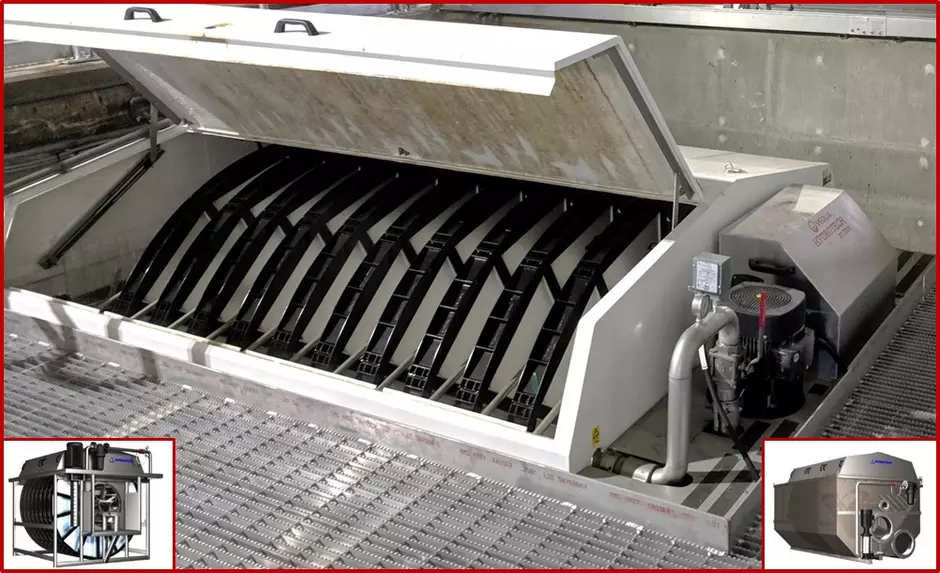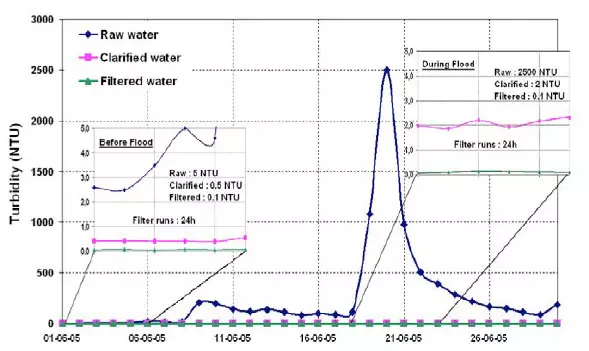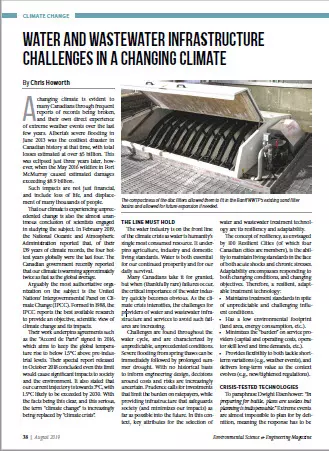Water and Wastewater Infrastructure Challenges in a Changing Climate
A changing climate is evident to many Canadians through frequent reports of records being broken, and their own direct experience of extreme weather events over the last few years. Alberta’s severe flooding in June 2013 was the costliest disaster in Canadian history at that time, with total losses estimated at over $5 billion. This was eclipsed just three years later, however, when the May 2016 wildfire in Fort McMurray caused estimated damages exceeding $8.9 billion.
Such impacts are not just financial, and include loss of life, and displacement of many thousands of people.
That our climate is experiencing unprecedented change is also the almost unanimous conclusion of scientists engaged in studying the subject. In February 2019, the National Oceanic and Atmospheric Administration reported that, of their 139 years of climate records, the four hottest years globally were the last four. The Canadian government recently reported that our climate is warming approximately twice as fast as the global average.
Arguably the most authoritative organization on the subject is the United Nations’ Intergovernmental Panel on Climate Change (IPCC). Formed in 1988, the IPCC reports the best available research to provide an objective, scientific view of climate change and its impacts.
Their work underpins agreements such as the “Accord de Paris” signed in 2016, which aims to keep the global temperature rise to below 1.5°C above pre-industrial levels. Their special report released in October 2018 concluded even this limit would cause significant impacts to society and the environment. It also stated that our current trajectory is towards 3°C, with 1.5°C likely to be exceeded by 2030. With the facts being this clear, and this serious, the term “climate change” is increasingly being replaced by “climate crisis”.
The Line Must Hold
The water industry is on the front line of the climate crisis as water is humanity’s single most consumed resource. It underpins agriculture, industry and domestic living standards. Water is both essential for our continued prosperity and for our daily survival.
Many Canadians take it for granted, but when (thankfully rare) failures occur, the critical importance of the water industry quickly becomes obvious. As the climate crisis intensifies, the challenges for providers of water and wastewater infrastructure and services to avoid such failures are increasing.
Challenges are found throughout the water cycle, and are characterized by unpredictable, unprecedented conditions. Severe flooding from spring thaws can be immediately followed by prolonged summer drought. With no historical basis to inform engineering design, decisions around costs and risks are increasingly uncertain. Prudence calls for investments that limit the burden on ratepayers, while providing infrastructure that safeguards society (and minimizes our impacts) as far as possible into the future. In this context, key attributes for the selection of water and wastewater treatment technology are its resiliency and adaptability.
The concept of resiliency, as envisaged by 100 Resilient Cities (of which four Canadian cities are members), is the ability to maintain living standards in the face of both acute shocks and chronic stresses. Adaptability encompasses responding to both changing conditions, and changing objectives. Therefore, a resilient, adaptable treatment technology:
• Maintains treatment standards in spite of unpredictable and challenging influent conditions.
• Has a low environmental footprint (land area, energy consumption, etc.).
• Minimizes the “burden” on service providers (capital and operating costs, operator skill level and time demands, etc.).
• Provides flexibility to both tackle short term variations (e.g., weather events), and delivers long-term value as the context evolves (e.g., new/tightened regulations).
Crisis-Tested Technologies
To paraphrase Dwight Eisenhower: “In preparing for battle, plans are useless but planning is indispensable.” Extreme events are almost impossible to plan for by definition, meaning the response has to be somewhat ad hoc. This does not mean prior experience is irrelevant, however.
On the contrary, a successful response relies heavily on established knowledge, relationships and instincts.
While no two events are the same, sharing lessons learned from previous events is invaluable. With over 172,000 employees around the world, and activities that include both treatment plant operation and the supply of treatment technology, Veolia works to reflect its global experience in improved process design, application, and O&M.
Various projects delivered by Veolia in Canada have recently been tested under extreme conditions, providing valuable experience in this regard.

The compactness of the disc filters allowed them to fit in the Banff WWTP’s existing sand filter basins and allowed for future expansion if needed.
Alberta Floods, 2005 and 2013
The City of Red Deer was the first city in Alberta to install Veolia’s Actiflo ® high rate clarification (HRC) technology. Their system, which has a design capacity of 120 MLD, was commissioned in 2003 at the city’s drinking water treatment plant (WTP). Within just two years it was crisis-tested when heavy rains in June 2005 caused major flooding, and resulted in 14 Albertan municipalities declaring official states of emergency.
Water quality in the city’s drinking water source (the Red Deer River) deteriorated very rapidly, spiking to a turbidity of over 2000 NTU in just two days.
Using the newly installed Actiflo process, operators were able to successfully clarify this water down to just 2 NTU, meaning downstream filter run times remained unchanged, and high quality filtered water quality was maintained.
Many other cities were forced to implement boil-water advisories during the event, and some subsequently choose to add Actiflo technology to their WTPs in light of Red Deer’s positive experience.
The City of Calgary is one example, where two WTPs were upgraded in 2007 and 2011, for a total HRC design capacity of over 1 billion litres per day. During the 2013 Alberta floods, raw water quality was even worse at both Red Deer’s and Calgary’s water treatment plants, but both cities were able to maintain fully compliant drinking water quality for their citizens.

Graph showing water quality at the Red Deer WTP , AB, before and during the 2005 flood.
Fort McMurray Wildfire, 2016
The Regional Municipality of Wood Buffalo (RMWB) also installed Actiflo technology at the Fort McMurray WTP, with commissioning of the 52 MLD system completed in 2014. The wildfire two years later tested the system in ways that were never envisaged when it was chosen.
Even though Fort McMurray was fully evacuated during the fire, the RMWB had to produce water at unprecedented volumes. In fact, at times the RMWB operated the WTP at over 150% of its design capacity. This was partly because firefighters relied on the drinking water distribution system for their supply, and also because fire damage caused system pressure loss. As buildings were burning down, their water supply lines were failing, creating numerous “open ends”.
The RMWB was acutely aware of the need to prevent the system losing too much pressure. Not only would this have impacted firefighting operations, but it could have compromised the network’s integrity, meaning extensive cleaning/disinfection would be needed before residents could return.
Impacts on the WTP are still not over. The fire burned 589,552 hectares, including large areas of the Athabasca River’s watershed. This affects the WTP’s raw water quality in various ways including:
• The loss of tree cover/vegetation (which attenuate stormwater runoff and stabilize the soil) means raw water is more turbid.
• Burned material releases dissolved organic carbon and nutrients such as phosphorus into the river, making it harder and less predictable to treat.
Veolia is working on forest fire related water treatment approaches with leading Canadian researchers in the field, who have identified Actiflo as a particularly helpful “tool to have in the toolbox”. Key reasons for this include its very short hydraulic retention time (making it more responsive to rapid raw water quality variations), and its robustness (meaning a wide range of contaminants, and high contaminant concentrations, can be treated effectively).
Chronic Challenges Lead to Innovation
Addressing the climate crisis will stretch our resources. Continuing with business as usual, however, has unconscionable costs. Smarter treatment technology, and efficient ways of applying it, can ease the burden. Two recent Canadian examples demonstrate this.
Peak Flow Treatment - North Vancouver
It rains a lot on Vancouver’s North Shore and it is expected to become even more intense as the climate changes. Consequently, the design of Metro Vancouver’s new wastewater treatment plant (WWTP), which will replace the old Lions Gate plant, had to accommodate relatively high wet weather peak flows.
Simply building the plant big enough for the peaks was one option, but it was decided a high rate “peak flow treatment” approach was significantly more efficient. This allowed the main plant to be sized to treat flows up to 204 MLD, with flows above this being treated by Actiflo.
The reasons the system was chosen included:
• The project site is constrained by neighbouring properties, a road, and a rail line, meaning Actilfo’s very high treatment rates (and hence small area requirement) were valuable.
• Actiflo starts up in less than 15 minutes, giving operators time to react to rainfall events.
• The first time Actiflo was applied for peak flow treatment in North America was in 2002 (in Bremerton, WA). Performance at that plant, and the many that have followed since, shows 90% suspended solids removal is typical in this application. This means WWTP effluent quality can be maintained at high levels even under extreme hydraulic loads.
The flexibility of Actiflo means the peak flow treatment system can be used for other applications during normal flow conditions, giving owners a “twofer” solution. Examples include use for tertiary treatment during dry weather to improve final effluent quality, and use as a chemically enhanced primary clarifier to improve suspended solids and phosphorus removal.
Actiflo has also been applied at “pinch points” in the wastewater collection system, to avoid untreated raw sewage discharges by treating overflows. These combined sewer overflows (CSOs) and sanitary sewer overflows (SSOs) are expected to become more common across Canada as rainfall events intensify and can release significant pollution loads into the environment.
Tertiary Filtration - Banff
The Town of Banff’s recreation/tourism based economy, together with very strict provincial and federal regulations, means the town’s WWTP strives to achieve exceptional treated effluent quality.
The WWTP’s tertiary filtration process is critical to meeting this goal, but the sand filter technology installed in 2002 was presenting increasing challenges in this regard. The town therefore issued a Request for Proposals in 2017 to retrofit to the latest textile media filtration technology (also known as disc filters). It sought to minimize costs by reusing as much existing infrastructure as possible, and used a Design-Build procurement model to promote innovation and minimize project schedule. Banff’s project requirements were uncompromising.
Not only did the retrofit have to be completed in the minimum possible shutdown period, but filtered effluent objectives were at the limit of the technology’s guaranteed performance capability. The solution chosen by the town employed two of Veolia’s Hydrotech® Discfilters.
Their compactness allowed them to fit across the width of one of the existing sand filter basins, and occupy less than half of its length (allowing for easy expansion in future). They also fitted within the existing hydraulic profile, meaning basin modifications were minimal.
Process performance testing significantly outperformed stipulated requirements. Even though the influent suspended solid load was above the design basis, filtered effluent suspended solids were significantly below the guaranteed limit, and were actually below the accredited laboratory’s detection limit.
The disc filters will therefore help the town minimize effluent loads on the environment, and can also enable wastewater reuse if required.
We Can Do This!
The climate crisis can be daunting. Now that we are aware of the need for action, it is time for a concerted effort from everyone at every level, personally and professionally. The tools and expertise we need to succeed already exist. By rising to the challenge we can put society on a truly sustainable path, ensuring prosperity for future generations.
Originally published in Environmental Science & Engineering Magazine, August 2019.



